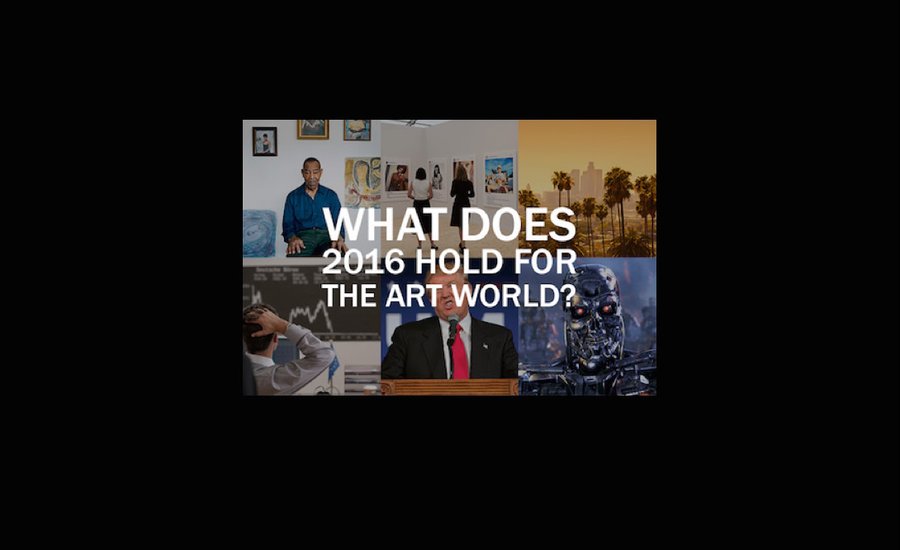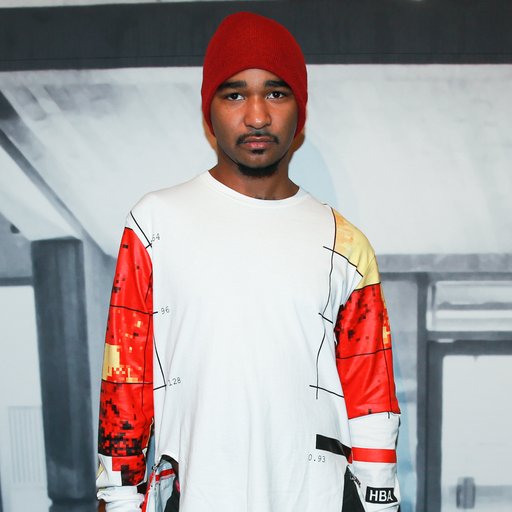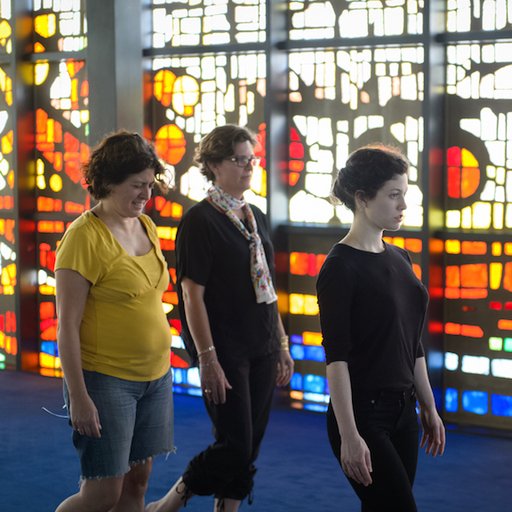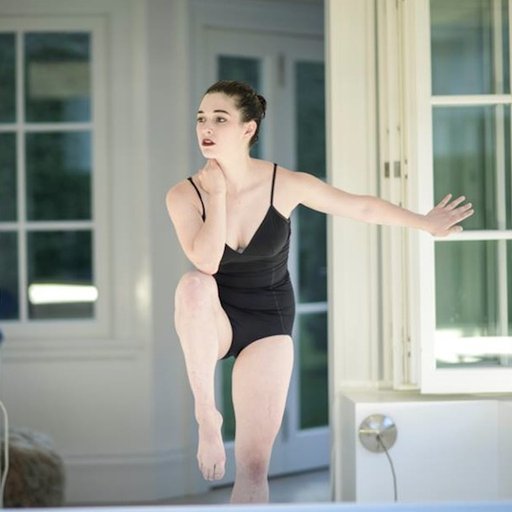With an upheaval-filled 2015 coming to a close, we here at Artspace Magazine have compiled a poll of artists, curators, critics, and assorted far-flung experts from the art field on a fairly streamlined topic: What is the single most significant development in art (or the art market) that they will be following in 2016?
A big question, to be sure. To throw a few ideas in the hat, I ventured that I will personally be following:
– Painting’s identity crisis, and whether the market will embrace new figuration
– The use and ethical ramifications of animals in art
– The continuing penetration of so-called “speculative realism”
– How (or if) artists react to the spread of extremism and the new phenomenon of social-media terror
– The potential recuperation of early digital art into the market at some point!
In their predictions, the respondents gamely ranged from the optimistic to the doom-y, from the practical and programmatic to the rather far-fetched. A few commonalities, however, can be discerned from their answers—and, if they’re on target, it should make for an exciting year. Herewith, read what they had to say.
****
“The overdue embrace of historic artists of color, by curators, critics, and collectors, continues to be the story I will be following (and sharing) in 2016. Despite recent gains and buzz, there is still much work to do to acknowledge the contributions of African-American artists over the past 50 years, in particular Sam Gilliam and his peers, whose use of abstraction further challenged the politics of representation in the art world. Given the current visibility of racial violence and rampant xenophobia, there is no better time than this coming year to advance a more diversified history and future for art.” – David Kordansky, gallerist
“1. This year saw the national art press attempting intersectionality to challenge inequities and discussing, however flawed, racism and privilege in the art world. Regardless, little progress has been made in the newsrooms. The ethnic complexion of those editors, journos, and critics leading the conversation has remained the same: monochromatic. In the new year we hope to see the inclusion of POC editors and journos in positions of real power inside the publishing machine.
2. Experts are claiming Zombie Formalism is dead because it has been failing to gain new ground in the market. If that turns out to be the case, I believe serious collectors and flippers will turn their focus and cash to untapped and somewhat forgotten inventories of the so called "old but new" guard and middle-of-the-road artists with proven exhibition records and critical acclaim. Longevity and experience will be seen as an asset once again.
3. The frenzied colonization of Cuban art by the market.” – Pedro Vélez, artist and critic
“I think the most significant development in art in 2016 will be the entrance of Cuban art into the market.” – Nilani Trent, Trent Fine Art Advisory
“POLITICS.” – Deborah Kass, artist
“It will be interesting to see how the practice of rediscovering artists from the past will evolve or devolve. It’s been refreshing to see intergenerational group exhibitions following years dominated by the obsession for the next new thing, but if on the one hand this had the benefit of finally giving overlooked artists their dues, on the other hand the sudden critical and marketing consensus they have enjoyed after years in the dark makes you question the whole art system, its sense of zeitgeist, and its capability to assess the relevance of artists when in their prime.” – Michele Robecchi, curator and editor of the Phaidon Contemporary Artists series
“As an antidote to zombies, ‘Forever Now’s, and flippers, I’m interested in the way that queer and feminist artists are plumbing abstraction for its political potential—something Harmony Hammond proposed back in 1977 in the second-wave journal Heresies. These painters, sculptors, video artists, and photographers are showing us that while abstraction was (and now is, again) the Boys Club style du jour, it can also be fertile ground for radical and non-binary propositions. Audre Lorde may have said you can’t use ‘the master’s tools,’ but a lot of artists are making a pretty good case that you can.” — Ashton Cooper, writer and artist liaison at Maccarone Gallery
“I’ll follow any artist or curator who upsets the status quo. Are there any? And I’ll follow any artist or curator (or writer) who won’t sit idly by while the world spins out of control.” – Linda Yablonsky, writer and curator
“That the art world and indeed other worlds will make parity (of gender, background, belief) a mission. That artworks made in digital and live processes and mediums will start exerting some power in the commercial arena. That all art schools will become free. That prickly, political, power-hungry, egotistical, bullying art-world types will get a softening makeover. That museums and art institutions will flex their cultural, intellectual, and curatorial muscle—and start putting on great shows that lead our thoughts and aspirations and show us the unknown and magical.” — David Gryn, founding director of Daata Editions
“The most significant development in art that I will be following in 2016 is the relationship between museums and artists using performance, dance, and choreography. Following the full emancipation of immaterial capital and the current trading of human knowledge and feelings (whether conscious or unconscious), I am interested in how the institution is changing its policies in order to host and acquire works of art that are based on full immateriality.” – Nicola Trezzi, U.S. editor of Flash Art International and head of the Bezalel Academy of Art’s MFA program
“With large quantities of hope and trepidation, I will be following the efforts of art workers, including artists, to create and strengthen unions and other forms of collective bargaining. I’ll also be tracking the degree to which museums and alternative spaces make real efforts to compensate artists (through W.A.G.E. certification and other means) and employees adequately. As inequality worsens throughout the world, it would be nice if the art industry started living up to the ideals many would like to believe it embodies. On a related note, I’m looking forward to seeing which artists in 2016 follow Lucien Smith’s bold lead in collaborating with real estate developers. And on an unrelated note, I’m very pumped for the Museum of Modern Art’s Francis Picabia show.” – Andrew Russeth, co-executive editor of ARTnews
“I will be paying close attention to exchanges between the field of contemporary art and new discoveries in science and technology. Since well-rounded innovation reflects a porosity between art, science, and tech, I will be tracking art's status as a field of exploration and discovery. The intelligence of sensation at the heart of artistic inquiry is the missing link in the current scientific paradigm, which will need the embodied perspective of firsthand experience to take the next leaps in quantum physics and the science of the mind. The further convergence of these fields will expand our rigorous exploration of the nature of reality. I will be following the potential instances for aesthetic experience to inform new discoveries of phenomena in the universe. In its highest form, art not only critiques and expresses—it also explores.” – Lia Chavez, artist
“I’ll be looking at the development of artworks, and metaphors more generally, that try to deal with the advent of machine-learning and how the rise of 'smart cities,' self-driving cars, and ubiquitous sensors are redefining 'seeing' and 'perception' in an increasingly post-human world.” – Trevor Paglen, artist
“I’m looking most forward to more developments with artist video-game concepts after our recent collaboration with the game studio TwoDots. It's wonderful seeing artists work in the unexpected new contexts that technology innovation is enabling!” – Stacy Engman, Art Capsul curator
“The single most significant development in art that I will be following is ROBOTISM, aka robot-generated art!” – Hyatt Mannix, arts media relations specialist at Kickstarter
“I don't think anything has changed much in art, at least not radically, but I do feel there has been a passive shift toward observation rather than action in art, and I don't mean activism. My sense is that there has been a shift into passive waiting and outwardly observing the world to see the directions things go in. For me in particular, I am keenly watching the shift in environmental policy and the escalation of violence, two things that will eventually become linked closely.” — Jordan Wolfson, artist
“I look forward to seeing whether gallery- and museum-goers tire of Instagramming essentially interchangeable, lame-o pictures of themselves posing in/near photogenic art installations, or if artists begin to make works that are increasingly conducive to selfie-taking 'as a commentary on our narcissistic age/shallow social-media-constructed identities'/for the free publicity.” – Emma Allen, art scribe, panelist, and “Shouts & Murmurs” editor at the New Yorker
“Will the market continue to confuse opportunism for cultural imagination?” – Michelle Grabner, artist and professor at the School of the Art Institute of Chicago
“I think the art-fair bubble may have reached its zenith in 2015 and we’ll start to see increasing interest in alternative and hybrid models during 2016. These will start to move further and further away from the luxury trade-show style of event that has now saturated the entire annual calendar. The intensity of the current fair calendar, the stress, the risk—it’s all terribly exhausting for everyone involved, and each year seems to leave participants in an even deeper kind of existential void. Similar to what’s happened with movements like Slow Food, I’ll be watching carefully for hints of new models that don’t ignore the need for a healthy, sustainable market but that seek to build deeper, more democratic, and more satisfying relationships and experiences.” — Brett W. Schultz, co-founder of Mexico City’s Material Art Fair
“I’m excited to see the Los Angeles gallery landscape develop under a growing spotlight as Hauser Wirth & Schimmel and Sprüth Magers join Maccarone by opening major L.A. outposts early in the year.” – Ellen Swieskowski, founder of the See Saw app
“I am interested in the highly unlikely, potentially powerhouse collaboration, like when Whitney collaborated with Mariah, Brandy, with Monica; Larry Gagosian with Jeffery Deitch; the blue-chip with the mid-level and so on. I am also interested in alternative/satellite art communities and what they have to offer in relationship to cultural centers like New York, Chicago, L.A., Berlin, and so on.” – Kalup Linzy, artist
“I’m following the rise of the temporary alternative exhibition space, be it a closet, shop window, or the Newtown waterfront site.” – Patton Hindle, director of gallery and institutional partnerships at Artspace
“My work being sold for tens of millions of pounds. And/or Marc Quinn disappearing.”— Jeremy Deller, artist
“What will be the strategic implications of the profound and multiple management changes at Christie’s and Sotheby’s? Who will prevail in the multiple lawsuits between Yves Bouvier and Dmitri Rybolovlev? What art-market practices will the case reveal? Now that the money-laundering potential of freeports is clear, what will be the attitude of the public authorities supervising them? Who will come out on top in the necessary distribution, displaying, transacting transformation of the video and digital art market among the different platforms aiming for this transformation? What will be the future of the mega-galleries losing their 70-plus-year-old founder (if it happens, of course)? Will Paddle8 or Auctionata or one of the big two auction houses take a firm lead in the online auction market? Who will prevail in the Simchowitz vs Ibrahim Mahama case?” – Alain Servais, collector
“How increasingly urgent geopolitical events—from the global climate crisis to ideological radicalization worldwide—will seep into the art world, as both artistic preoccupation and as business context.” — András Szántó, writer, teacher, and art consultant
“I think the political aspect of the world in general is something to take into consideration, including the huge amount of problems related to radicalism in Europe and the U.S. and the idea of further ghettoizing the 'other,' i.e. Arabs and Muslims. We hear so much about boycotts and the evils of certain regimes—for example with the death sentence of Ashraf Fayadh in Saudi Arabia—but so rarely do these international public figures in the art world try to engage with these situations and make a difference from within.” — Alia Al-Senussi, head of VIP Relations for the Middle East at Art Basel
“Although I don't necessarily understand art in terms of system-wide developments, I expect to think even more in 2016 about artists who employ directly personal content while managing to address broad political or philosophical subjects. I expect to be more aware than ever that artists are alive, and that they are always performing their identities and the conditions of their lives, whether they mean to or not. In a period defined by systems and information and distance, art feels more and more necessary to me as a vehicle for intimacy.” — Forrest Nash, founder of Contemporary Art Daily
“I will be watching to see how painting is further declared dead. I will also be watching the debate between abstract painting and figurative painting. One of them is always going up while the other is going down. In the meantime, I am going to stay in my studio and do my work no matter what anyone says about either of them.” — Betty Tompkins, artist
“I will be following the ripple effect of MoMA’s 'Picasso Sculpture' show on artists. Every so often there are large-scale historical exhibitions that have a resounding effect on artists, cleverly curated to provide meat for us to gnaw on for months as to how a historical artist’s ideas were groundbreaking then and prescient now. 'Picasso Sculpture' is such a show, providing a framework for reinvestigating Surrealism, and perhaps providing a formal environment to sift through the confusion of our intense political climate, as it did at the beginning of the 20th century.
Personally, Picasso's exhaustive exploration of heft and space incites me to tease sculptural mass out of my painting, something I've been doing peripherally, but this show kind of kicked my ass emphatically down that road. I see the Picasso effect in activity in friends' studios—in Michelle Segre's buoyant investigations of mass and fragility, in Carl D'Alvia's warped rhombi and 3-D animalier collages that look towards an uncertain futuristic demise, in Hillary Harnischfeger's carved 2-D/3-D spaces, and in Matthew Weinstein's ever-surreal animations.
"I’m also paying close attention to painters playing with forms and mass, as in Bill Adams’s dense drawings of animals flattened by surface, Tommy White's plaster works, Kaitlin McDonough's minute painting cubes, and Carroll Dunham combining his formidable drawing skills into laser-cut 3-D clusters. I'm excited to see how this all plays out in 2016.” — Jackie Saccoccio, painter
“All kinds of art making interests us—figurative and abstract, analog and digital, intellectually challenging and easily accessible. The line between fine art and craft—particularly ceramics—has softened. It almost seems like anything goes as long as the artist is putting his or her essential self into the work. The rule is there are no rules. One of the most interesting exhibitions we saw recently was at the Jewish Museum called 'Unorthodox.' It included video, painting, sculpture, ceramics, et cetera, and featured both artists who went to art school and who didn't. Originality ruled. That's what we like, and expect to see more of in 2016.” — Joel and Zoe Dictrow, collectors
“I think the answer to that is really at the core of why we collect—we don’t know that answer. We’re on the street looking and learning, so that potentially we can answer that question, and I think there’s a danger in trying to identify themes or ideas too early. I think the process of investigation is what’s at the core of art collecting, and perhaps it’s the most interesting way to go about it. To try to lump things in a category too early is a mistake. The fun is to learn about it as it’s happening, and make judgments and form feelings about new bodies of work.” — Thea Westreich Wagner, collector, patron, and founder of Thea Westreich Art Advisory Services
“The most significant goal for my gallery this year will be the same one we have pursued from the very beginning when I opened the gallery: striving to achieve equal success in terms of exposure, recognition, and price structure for all artists in my program, regardless of their gender or cultural background. Given the fact that, in a larger context, female artists in 2015 still have not received parity with their male counterparts, this is an area where we continue to make a concentrated effort to raise awareness.” — Suzanne Vielmetter, gallerist
“Collectors have many choices. There are a great deal of artists worth loving, and we buy what we love. However what we are watching and will continue to watch in 2016 is relative pricing. It concerns us that many younger artists have had their prices hiked well beyond what their CVs might suggest in terms of exhibitions and institutional support. This is unhealthy for the artist and the art market. If young artists and their galleries do not keep prices under control, then institutions will have difficulty buying in, and pricing will not correspond to CVs.
"We keep a close eye on relative pricing and have been and will continue to choose one great work by a mid-career artist who is in good collections and has institutional support over two works by a young artist who has been priced out of the game with regard to their CV. Also we will continue look for and collect work by great young artists who are represented by galleries that strive to place the works in good collections and institutions.” – Carole Server and Oliver Frankel, collectors
“I’m following two trends: the exodus of Chelsea galleries to the Lower East Side, and a secondary-market correction at the auction houses.” — Sue Stoffel, collector
“That art is now a luxury good—the prices are crazy. Eventually there will be a crash.” – Michael Hort, collector
“Price transparency in the art world.” – Magnus Resch, founder of Larry’s List and author of Management of Art Galleries
****BONUS SECTION****
Two respondents took my own areas of interest above as a springboard for commentary. Here is what they had to say.
DARREN BADER, ARTIST:
– Painting’s identity crisis, and whether the market will embrace new figuration
This is only an identity crisis for paranoid people.
– The use and ethical ramifications of animals in art
Hopefully some thought will be given to this. I've learned quite a bit from my uses of animals. Ethics is difficult to pin down (especially across cultures).
– The continuing penetration of so-called “speculative realism”
I’m not convinced art based on speculative realism would be distinguishable from most any art. Philosophy is not science, and neither is art.
– How (or if) artists react to the spread of extremism and the new phenomenon of social-media terror
They will, and it will likely be some of the more interesting art in the coming months/years.
– The potential recuperation of early digital art into the market at some point
Carol Greene will be one of the first?
JERRY SALTZ, ART CRITIC:
– Painting’s identity crisis, and whether the market will embrace new figuration
I was unaware that painting was in anymore of a co-called (!!) "identity crisis" as it has ever been! Really. And who the hell cares what the market will or won't "embrace"? We have no theory of the market therefore there is now way to even talk about it sensibly without getting depressed and sleepy. I think painting is breaking out all over. And doing pretty great of late. But I honestly do not know what this so-called "new figuration" is. It can't possibly be anyone not painting is ways that are called—wrongly, of course, in shorthand parlance—“abstract." All two-dimensional rendition of the world is by-nature abstract. The greatest imaged information technology ever developed—in the caves—by our species. "New figuration"! It makes my skin crawl.
– The use and ethical ramifications of animals in art
Fuck anyone raging against Gavin Brown's Enterprise for giving New York the tremendous gift of re-staging Jannis Kounellis’s great 1969 work of early Arte Povera Untitled (12 Horses). I wish that they'd worry about something a little closer to home. Or go ahead: Protest a 1969 art work for not meeting your high humanistic standards.
– The continuing penetration of so-called “speculative realism”
I must really be out of it! As with the first term "New Figuration," I can't say that I have a clear idea about what is meant by "Speculative Realism.” Like Cave paintings? Mondrian's Broadway Boogie Woogie? Chris Burden's Shoot? Or just ZoFo?
– How (or if) artists react to the spread of extremism and the new phenomenon of social-media terror
I thought that the cinema-in-the-expanded-field of Hito Steyerl was pretty riveting and harrowing. I don't think that it has anything to do with your question, "spread of extremism and the new phenomenon of social-media terror."
– The potential recuperation of early digital art into the market at some point
What the fuck is this supposed to mean? The market recuperation for "early digital art"? I am really out of it. Early digital art? #Seurat #Monet #vanGogh? Give me a drawing by van Gogh or Seurat and I'll show you the recuperation of "early digital art.”



























